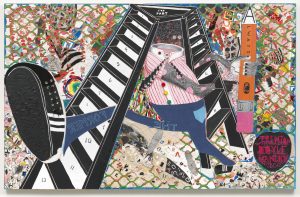
Lesson Concept: Thought Ladder
Spending time with a work of art can be an opportunity for thoughtful inquiry and ideation. For students, documenting their ideas as they work to interpret an artwork offers the chance to exercise metacognition. The Thought Ladder activity helps students build their interpretations step by step while giving them insight into the way they are processing their observations and forming their ideas.
Objectives
- Students will build their interpretations step by step.
- Students will document their thinking, and gain insight into the way they are processing their observations.
Activity
Adjust this activity in whatever way makes sense for your classroom. The instructions below are merely an outline for students to document their thinking.
Invite students to use the steps below to spend at least 10-15 minutes with a work of art, challenging them to document the ideas it presents to them.
Ask them to refrain from reading information about the art until they are fully familiar with the visual aspects of the work, and have formed thoughts about what they see.
Choose from the objects below or visit the VMFA Collections page to search for other possibilities:
First Impressions
This first step is simple. Take note of the very first thing that comes to mind as you first glance at this artwork. Write it down.
Visual Inventory
Now it’s time to get better oriented and take a closer look. For this step spend a full minute making a visual inventory.
- Observe the piece even more slowly and carefully. Let your eyes slowly wander around the entire artwork.
- Make a list of everything you observe in the piece.
- Try not to judge your observations – no observation is too simple or too small!
Take Stock
Great! Now take a few moments to see what ideas you have to work with.
- Take a moment to reconsider your first reaction.
- Write down new thoughts that you are starting to have about the piece – these new thoughts might build upon your first reaction, or they might be completely new ideas.
- What do you find interesting about the piece?
- What do you find frustrating about the piece?
- What do you think the artist might be trying to convey?
Curiosities
Now it’s time to build on your ideas a little bit more by thinking about what questions they stimulate for you. Consider the following and write down your thoughts. Refer back to the artwork as well as what you have already written down.
- What questions do you have about this piece?
- What do you want to know more about?
Discuss and Build
Discuss your individual findings with a partner or a group. Compare your experience and ideas.
- What was your first reaction to the piece?
- How did your first reaction grow or change as you spent more time observing the artwork?
- What do you think the artist might be trying to convey?
- What are you left wondering about?
- Were there any ideas the group had in common? Any that were new to you?
Find out more!
Finally, read the label copy available about this artwork. Consider the date, place, and material with which it was made. Look at the artist’s name and culture.
- How does this information add to your understanding of the artwork?
- What search terms can you add to the questions your thought ladder generated to conduct further research about this artwork?
Graphic Organizer
You may wish to print and distribute this graphic organizer to help students document their ideas.




